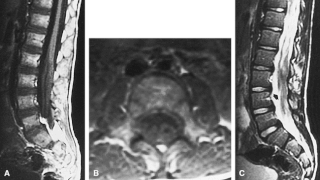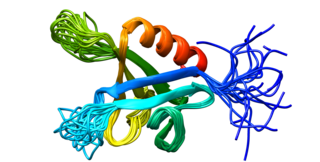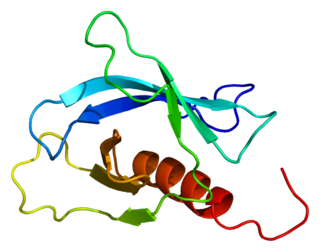
Dejerine–Sottas disease, also known as, Dejerine–Sottas syndrome, hereditary motor and sensory polyneuropathy type III, and Charcot–Marie–Tooth disease type 3, is a hereditary neurological disorder characterized by damage to the peripheral nerves, demyelination, and resulting progressive muscle wasting and somatosensory loss. The condition is caused by mutations in various genes and currently has no known cure.

Laminopathies are a group of rare genetic disorders caused by mutations in genes encoding proteins of the nuclear lamina. They are included in the more generic term nuclear envelopathies that was coined in 2000 for diseases associated with defects of the nuclear envelope. Since the first reports of laminopathies in the late 1990s, increased research efforts have started to uncover the vital role of nuclear envelope proteins in cell and tissue integrity in animals.

Trifunctional enzyme subunit beta, mitochondrial (TP-beta) also known as 3-ketoacyl-CoA thiolase, acetyl-CoA acyltransferase, or beta-ketothiolase is an enzyme that in humans is encoded by the HADHB gene.

Gap junction beta-1 protein (GJB1), also known as connexin 32 (Cx32), is a transmembrane protein that in humans is encoded by the GJB1 gene. Gap junction beta-1 protein is a member of the gap junction connexin family of proteins that regulates and controls the transfer of communication signals across cell membranes, primarily in the liver and peripheral nervous system. However, the protein is expressed in multiple organs, including in oligodendrocytes in the central nervous system.

Dynamin-2 is a protein that in humans is encoded by the DNM2 gene.

Early growth response protein 2 is a protein that in humans is encoded by the EGR2 gene. EGR2 is a transcription regulatory factor, containing three zinc finger DNA-binding sites, and is highly expressed in a population of migrating neural crest cells. It is later expressed in the neural crest derived cells of the cranial ganglion. The protein encoded by Krox20 contains two cys2his2-type zinc fingers. Krox20 gene expression is restricted to the early hindbrain development. It is evolutionarily conserved in vertebrates, humans, mice, chicks, and zebra fish. In addition, the amino acid sequence and most aspects of the embryonic gene pattern is conserved among vertebrates, further implicating its role in hindbrain development. When the Krox20 is deleted in mice, the protein coding ability of the Krox20 gene is diminished. These mice are unable to survive after birth and exhibit major hindbrain defects. These defects include but are not limited to defects in formation of cranial sensory ganglia, partial fusion of the trigeminal nerve (V) with the facial (VII) and auditory (VII) nerves, the proximal nerve roots coming off of these ganglia were disorganized and intertwined among one another as they entered the brainstem, and there was fusion of the glossopharyngeal (IX) nerve complex.

Kinesin-like protein KIF1B is a protein that in humans is encoded by the KIF1B gene.

Surfeit locus protein 1 (SURF1) is a protein that in humans is encoded by the SURF1 gene. The protein encoded by SURF1 is a component of the mitochondrial translation regulation assembly intermediate of cytochrome c oxidase complex, which is involved in the regulation of cytochrome c oxidase assembly. Defects in this gene are a cause of Leigh syndrome, a severe neurological disorder that is commonly associated with systemic cytochrome c oxidase deficiency, and Charcot-Marie-Tooth disease 4K (CMT4K).

Lipopolysaccharide-induced tumor necrosis factor-alpha factor is a protein that in humans is encoded by the LITAF gene.

Ganglioside-induced differentiation-associated protein 1 is a type of protein that in humans is encoded by the GDAP1 gene.

Transmembrane protease, serine 3 is an enzyme that in humans is encoded by the TMPRSS3 gene.

Periaxin is a protein that in humans is encoded by the PRX gene.

Myotubularin-related protein 2 also known as phosphatidylinositol-3,5-bisphosphate 3-phosphatase or phosphatidylinositol-3-phosphate phosphatase is a protein that in humans is encoded by the MTMR2 gene.

Myotubularin-related protein 13 is a protein that in humans is encoded by the SBF2 gene.

E3 ubiquitin-protein ligase LRSAM1, previously known as Tsg101-associated ligase (Tal), is an enzyme that in humans is encoded by the LRSAM1 gene.

Neuregulin 2, also known as NRG2, is a protein which in humans is encoded by the NRG2 gene.

FYVE, RhoGEF and PH domain-containing protein 3 is a protein that in humans is encoded by the FGD3 gene.

FYVE, RhoGEF and PH domain-containing protein 4 is a protein encoded in humans by the FGD4 gene.

Coiled-coil and C2 domain-containing protein 2A that in humans is encoded by the CC2D2A gene.

FYVE, RhoGEF and PH domain-containing protein 2 (FGD2), also known as zinc finger FYVE domain-containing protein 4 (ZFYVE4), is a protein that in humans is encoded by the FGD2 gene.
























